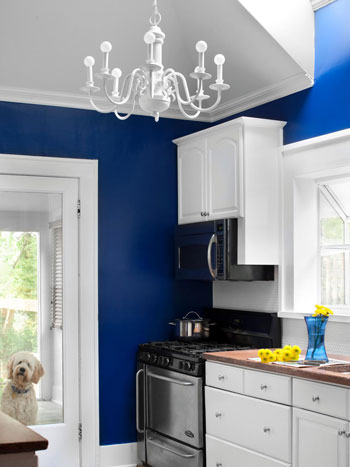Dana George-Berberich, CORRESPONDENT
BAY AREA NEWS GROUP, Saturday, March 1, 2014
Furnishing a Tiny Space (Download Original Article pdf)
It is perhaps a remnant of 1980s excess, but there are those who firmly believe that bigger is better. The design world, however, does not seem to hold to the notion. Designers say that decorating a small living space can be every bit as satisfying as filling an 8,000 square-foot house. Even the tiniest living space can be comfortable, well-appointed, and aesthetically stunning.
 “There’s been a kind of prevailing wisdom in design and decorating that says if you have a small space you should paint it all white or another neutral color to make it feel bigger,” said Rachelle Padgett, owner of Berkeley-based Synthesis Interiors & Color. “I don’t think that’s the case anymore. If you love color, use color. I’m less concerned about one particular element and more concerned with the entire package. For example, if someone wants a bright red wall, that’s fine. Just find a way to balance it out by using more neutral colors in other elements of the room.”
“There’s been a kind of prevailing wisdom in design and decorating that says if you have a small space you should paint it all white or another neutral color to make it feel bigger,” said Rachelle Padgett, owner of Berkeley-based Synthesis Interiors & Color. “I don’t think that’s the case anymore. If you love color, use color. I’m less concerned about one particular element and more concerned with the entire package. For example, if someone wants a bright red wall, that’s fine. Just find a way to balance it out by using more neutral colors in other elements of the room.”
Padgett knows firsthand of which she speaks. She and her husband own a 950 square-foot house and she “can’t imagine that we would need more.”
According to experts, living well in a small space involves following three principles: editing possessions, using color to your advantage, and utilizing clever storage.
Edit
Editing is perhaps the most difficult stage of design for many people. “I work with a lot of people who really struggle with parting with things of sentimental value,” Padgett said. “But if it doesn’t fit, it doesn’t fit.”
In his work as a professional organizer, Steve Adams, owner of Creative Space Organizing, runs into the same issue. “I often meet people who are in a state of being overwhelmed, a state where they can’t let things go. But things are just stuff. The only reason something has meaning is because we ascribe meaning to it.”
According to Adams, the average person rarely, if ever, uses 80 percent of their possessions. It is the other 20 percent—items used on a consistent basis—that should be considered first. Once a person knows that they are keeping 20 percent of their possessions, they are free to determine how much of the rest they truly need. Look at each of your possessions and determine how relevant it is to your everyday life. Then, decide whether you are going to toss it, donate it, or absolutely must keep it. Adams calls clutter “unmade decisions,” and promises that getting rid of unneeded items does get easier. “Purging is like a muscle. Once people make one round of their possessions and get rid of some things, they realize that it is okay.
They will come back around and say, ‘You know, I don’t need that.’”
 One trick he utilizes when it comes to sentimental items is “archiving.” If a client has old concert T-shirts, artwork created by their children, or any other space-consuming, albeit sentimental item, Adams encourages them to take a photograph of the item and allow the picture to act as a keepsake before getting rid of the actual possession.
One trick he utilizes when it comes to sentimental items is “archiving.” If a client has old concert T-shirts, artwork created by their children, or any other space-consuming, albeit sentimental item, Adams encourages them to take a photograph of the item and allow the picture to act as a keepsake before getting rid of the actual possession.
When it comes to paring down the amount of furniture in a small space, designer Paige Loczi, owner of LOCZIdesign, says that there has been an “urban legend” of sorts that maintains “the fewer pieces, the better.” Loczi says that it is not actually the number of pieces of furniture in a room, but rather their proportion and scale. Properly proportioned furniture will provide a natural traffic flow, a path through each room that makes it easy to get around.
The professionals agree that the first step in designing a beautiful small home is to utilize furniture that is properly proportioned to each room. Padgett says that there are “lots of great resources at the retail level for furniture scaled for smaller living spaces.” She says that people should ask themselves if they really need that extra furniture currently taking up space.
Use color
“A bucket of paint and some plants go a long way to make a house feel lively and lived in,” said Loczi. “Stick with colors that make you feel good. That will be different for everyone. You have to really go with your instinctive response to something.”
There was a time when the rule of thumb was that neutral colors only could be used in small areas. “I don’t think that’s the case anymore. If you love color, use color. I’m less concerned about one particular element and more concerned about the entire package,” said Padgett.
For example, if one of Padgett’s clients wants a bright red feature wall, the designer will find a way to balance the wall, often by incorporating neutral furnishings. According to Padgett, it’s all about how the pieces of the puzzle come together. People should not be scared off by bold colors as long as the finished product is a “balanced” room.
Loczi insists that there is no need to fear patterns, even in small spaces. “Try distracting wallpaper,” she said, “something graphical and linear. Allow it to be cozy and have a lot of personality; play it up.”
Even a space as small as a powder room or kitchen can benefit from bold color. Padgett and Loczi are both fans of covering the ceiling with the same paint or paper on the walls. Padgett says that covering the ceiling “erases that line of demarcation and makes the space feel bigger.”
Other tips include painting walls, trim, and baseboard the same color to create a less chopped-up look, and being careful to match the color intensity throughout your home. While Loczi “jumps levels of color” throughout the homes she decorates, she is careful to ensure that the color in each room has the same intensity. “Colors need to have the same potency, the same amount of chroma,” she said.
“Choose colors that are side-by side on the color spectrum rather than going up or down.”
Tips to Create Storage
- Approximately six feet up the wall, install a vertical ledge running down both sides of a hallway. Loczi suggests displaying books there and attaching a thin wire in front to prevent them from falling in the event of an earthquake.
- Purchase the tallest bookshelves that will fit into a room in order to take full advantage of available space. Find decorative baskets that speak to the aesthetics of a room and line them up on the bookshelf as storage.
- Go vertical. Any empty area can be used as storage. Add shelving and keep things like photographs or old letters up high and in the back. Keep anything you use on a regular basis at a level you can easily access.
- Adams suggests that people consider less-traditional furniture. There are bed designs that allow the mattress to lift up and the hollow area beneath to be used as storage. Consider the purchase of coffee tables and ottomans that double as storage.
- Utilize space bags to store pillows and comforters not regularly used.
- Use drawer dividers in order to organize all the little things around the house, such as batteries, menus, pens, and tools.
- Replace big wooden hangers with “huggable” hangers in order to save 25 percent of closet space.
- Walk through a container store to find new gadgets that will help you make the most of very small spaces, like pantries and cupboards.
At the end of the day, your home is your home, regardless of size. Using properly proportioned furniture, paint and wallpaper that expand rather than contract the space, and cleverly storing your possessions will go a long way toward making it feel as though your space has the decorator touch.
Loczi summarized by saying, “It’s about surrounding yourself with things that bring you joy.”
Rachelle Padgett is on Houzz, Facebook, LinkedIn, Pinterest, Instagram, and Yelp.






